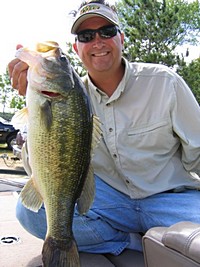Choosing the Right Plastic
By: Deitz Dittrich

Fishing is a lot of fun, however, choosing
the right lure to throw for the day can often
feel quite overwhelming. Case in point: I
just roughly counted the number of
plastics in the new 2007 MisterTwister
Catalog and arrived at 362 different sizes,
shapes, and colors–and that was just in
the Exude formulation! I can’t imagine
trying to count the regular formulation,
and then to add all the other companies
plastics and WOW… brain overload. One
does not have the expendable income to
even buy just one of every lure, let alone
a pack of them. So this article will maybe
help you decide on a few colors of a few
shapes to best fit your fishing style.
When fishing, the first thing to consider is the species of fish you are
after. It would be quite silly to cast a 9” Sassy Shad if your goal for the
day is to catch Crappies. “Match the hatch” is a motto that applies to
more than just stream trout anglers. Once you have decided the
species of fish you are after, you can narrow your search for the
perfect lure.
Your next step should be to look at water clarity and light penetration.
Each body of water is different and can change from day to day and
hour to hour depending on cloud cover. As a result, a lure that worked
even a few hours before may or may not be the best choice for the
present. The clearer the water, the more natural a color you want to
choose. The brighter a day is, the brighter a lure you want to choose.
This seems contrary to belief to many, but throughout my many years
of fishing this is what seems best. Natural and dark colors include
black or June bug. Natural and brighter colors include Watermelon
seed, Pumpkin Pepper, and of course, white. Colors that are good for
partly cloudy days include Watermelon seed/red flake, Goby or Smoke.
When fishing a stained body of water, you will start to use colors that
are less natural. One color I would use in stained water on a bright day
would be chartreuse, or pink, something bright to get the fish’s
attention. On darker days, black/blue or red shad should do the trick..
Water clarity will also play a role in what shape plastic you choose as
well. The clearer the water you will be fishing, again, the more natural
a lure you would choose. If you are trying to match the hatch, fish in
clear water feed more by sight than a fish that lives in murky water
who feeds more on sound and vibration. A good example of a natural
looking lure for bass is the Exude RT Slug. This lure resembles a
baitfish. However, the color of that baitfish will be different depending
on which part of the country you live in. In Southern parts of the
country, the color Alewife may do a good job of looking like a small
shad, however, many states do not have shad. I prefer to use Croaker
Shad, which I feel looks a lot like a small sunfish.
Other natural looking lures would be the Crawler and Tube. For
stained water you can use the plastic to draw the fish in. Choosing a
plastic that would have some vibration to it will help that fish find your
lure. All plastic will put out a vibration, however, some put out a lot
more. The larger a piece of plastic is, the more water it will move and
thus put out more vibration. Lures with twister tails or paddle tails on
them will also put out a lot more vibration. For example, even though
the Exude Nightcrawler and the Exude Wide Ribbon Tail worm are
about the same size, the Ribbon tail worm puts out considerably more
vibration than the crawler. The BA Hog and Lizzard also put out a lot of
vibration.
Finally, weather should play a large role in how you choose your
plastic. If conditions for fishing are tough, like a cold front, you would
choose a smaller profile lure. Usually during a cold front the fish are
not looking for a meal, however, maybe they would eat a snack. This is
called downsizing. Yet, if you are fishing and the weather has been
fairly stable for a few days, you would be better off fishing a larger lure
as you may have a better chance of catching a larger fish on a larger
piece of plastic. For example, if you were catching walleye on a 4”
Twister tail, and found yourself in a cold front situation, dropping
down to a 3” twister may help out. If the weather stayed nice and you
were maybe looking to catch some bigger fish, switching to a 4” Sassy
Shad may be the ticket as this lure has a larger profile.
So, by paying attention to the details:
• Species of Fish
• Water Clarity
• Light Penetration
• Weather
Then choosing a plastic to match those conditions, you should catch
more fish! Lastly, rules are meant to be broken. I have had many a day
saved when I broke the rules and used a lure the fish should not have
liked for the day. However, I will most always start with the basics I
listed above.
Good luck out there and have fun!
Deitz Dittrich
FishingMN.com Pro Staff
